Understanding Business Environment and Strategy
VerifiedAdded on 2020/06/06
|11
|3216
|32
AI Summary
This assignment examines the concept of the business environment, emphasizing its internal and external dimensions. It delves into analytical frameworks such as PEST analysis, Porter’s Five Forces, SWOT analysis, and value chain analysis to assess both the internal strengths and weaknesses of a firm, as well as the opportunities and threats posed by the external environment. The assignment further explores the importance of strategy in guiding an organization's direction, achieving objectives, gaining competitive advantage, and responding effectively to environmental changes.
Contribute Materials
Your contribution can guide someone’s learning journey. Share your
documents today.
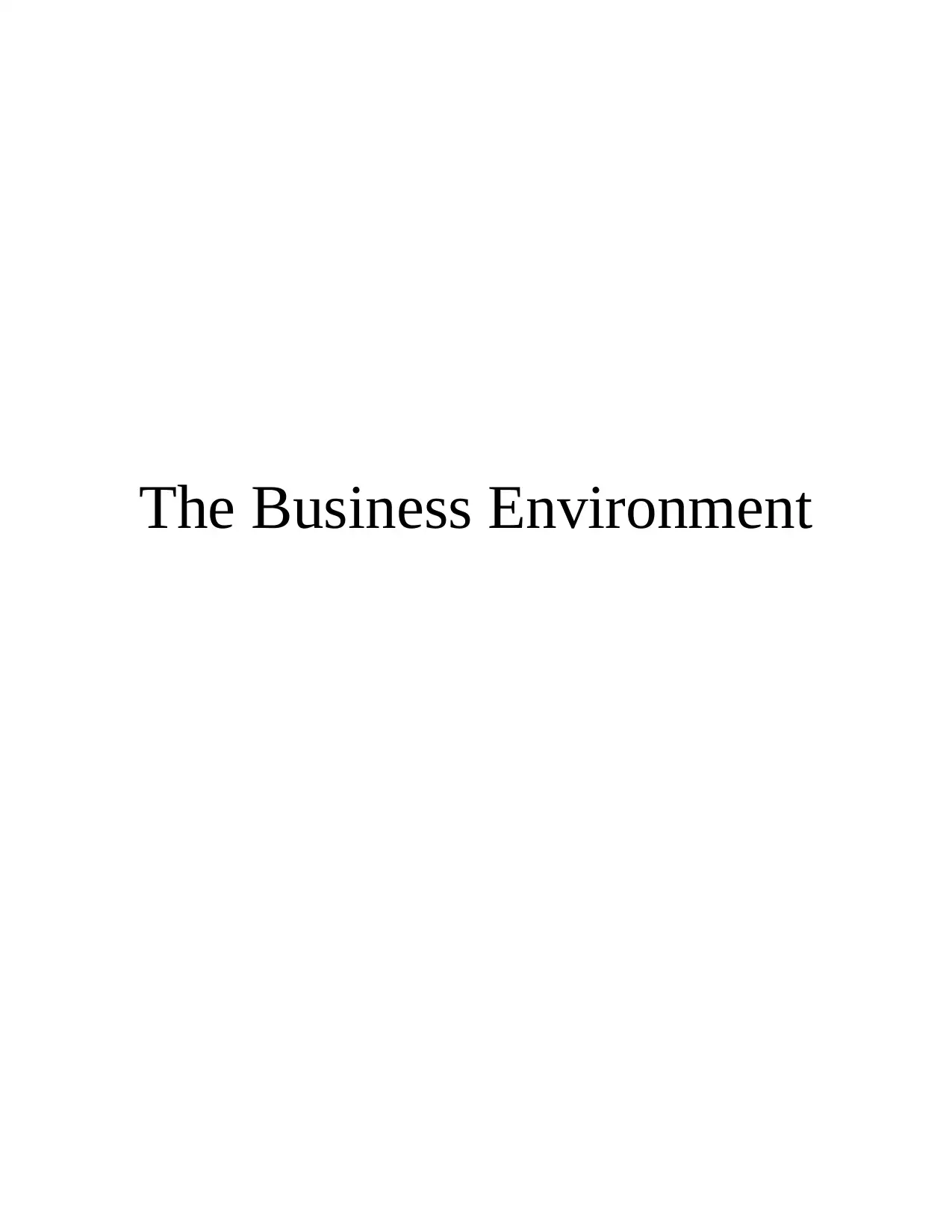
The Business Environment
Secure Best Marks with AI Grader
Need help grading? Try our AI Grader for instant feedback on your assignments.
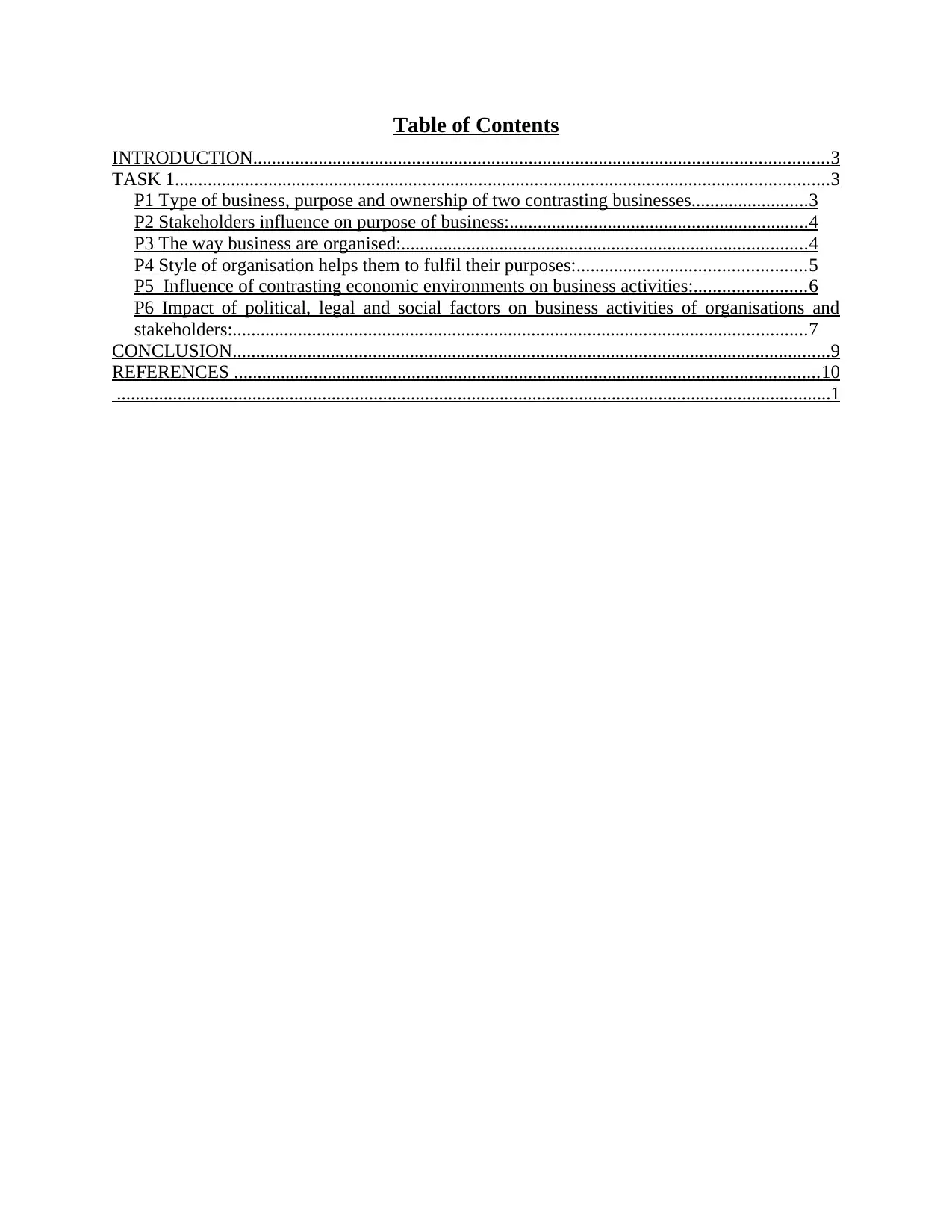
Table of Contents
INTRODUCTION...........................................................................................................................3
TASK 1............................................................................................................................................3
P1 Type of business, purpose and ownership of two contrasting businesses.........................3
P2 Stakeholders influence on purpose of business:................................................................4
P3 The way business are organised:.......................................................................................4
P4 Style of organisation helps them to fulfil their purposes:.................................................5
P5 Influence of contrasting economic environments on business activities:........................6
P6 Impact of political, legal and social factors on business activities of organisations and
stakeholders:...........................................................................................................................7
CONCLUSION................................................................................................................................9
REFERENCES .............................................................................................................................10
.........................................................................................................................................................1
INTRODUCTION...........................................................................................................................3
TASK 1............................................................................................................................................3
P1 Type of business, purpose and ownership of two contrasting businesses.........................3
P2 Stakeholders influence on purpose of business:................................................................4
P3 The way business are organised:.......................................................................................4
P4 Style of organisation helps them to fulfil their purposes:.................................................5
P5 Influence of contrasting economic environments on business activities:........................6
P6 Impact of political, legal and social factors on business activities of organisations and
stakeholders:...........................................................................................................................7
CONCLUSION................................................................................................................................9
REFERENCES .............................................................................................................................10
.........................................................................................................................................................1
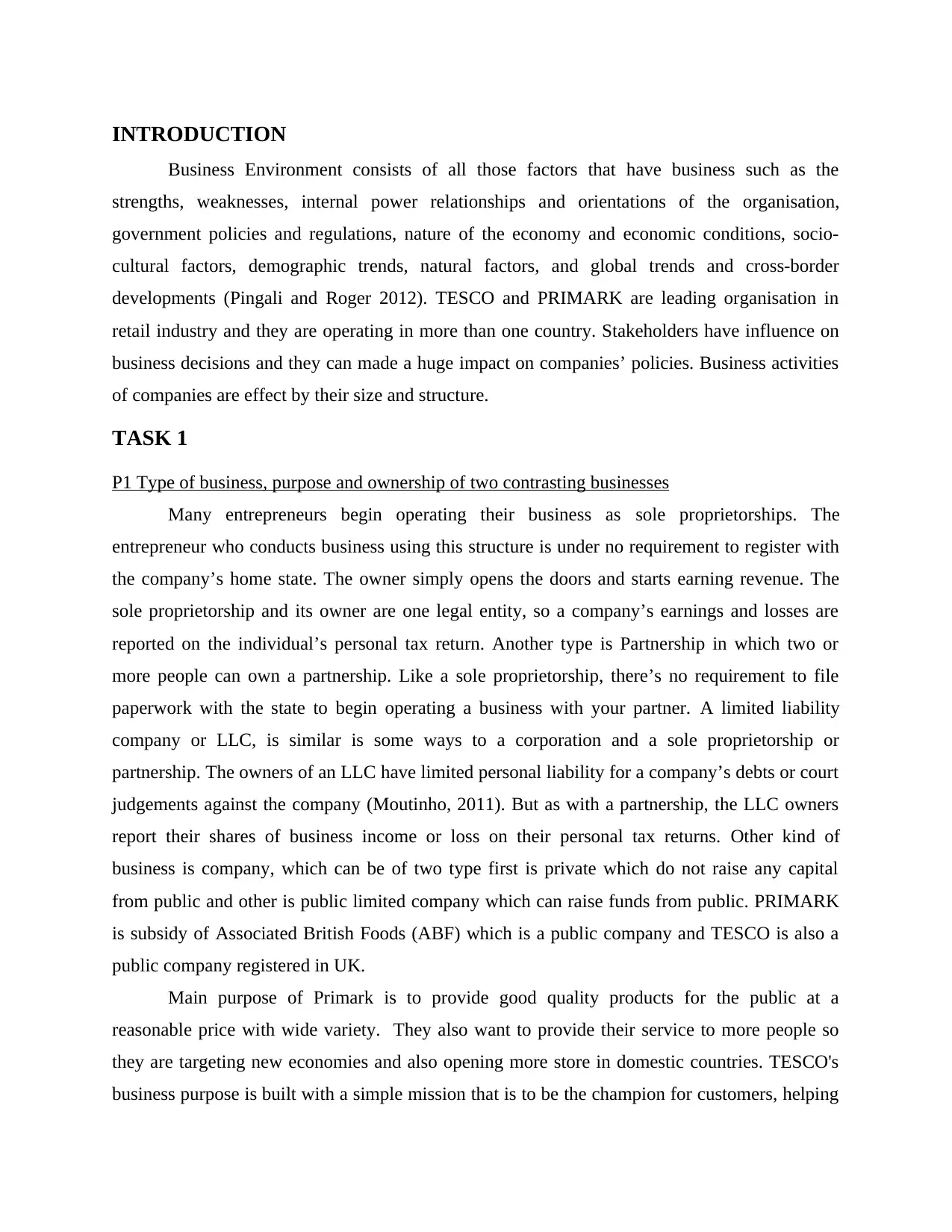
INTRODUCTION
Business Environment consists of all those factors that have business such as the
strengths, weaknesses, internal power relationships and orientations of the organisation,
government policies and regulations, nature of the economy and economic conditions, socio-
cultural factors, demographic trends, natural factors, and global trends and cross-border
developments (Pingali and Roger 2012). TESCO and PRIMARK are leading organisation in
retail industry and they are operating in more than one country. Stakeholders have influence on
business decisions and they can made a huge impact on companies’ policies. Business activities
of companies are effect by their size and structure.
TASK 1
P1 Type of business, purpose and ownership of two contrasting businesses
Many entrepreneurs begin operating their business as sole proprietorships. The
entrepreneur who conducts business using this structure is under no requirement to register with
the company’s home state. The owner simply opens the doors and starts earning revenue. The
sole proprietorship and its owner are one legal entity, so a company’s earnings and losses are
reported on the individual’s personal tax return. Another type is Partnership in which two or
more people can own a partnership. Like a sole proprietorship, there’s no requirement to file
paperwork with the state to begin operating a business with your partner. A limited liability
company or LLC, is similar is some ways to a corporation and a sole proprietorship or
partnership. The owners of an LLC have limited personal liability for a company’s debts or court
judgements against the company (Moutinho, 2011). But as with a partnership, the LLC owners
report their shares of business income or loss on their personal tax returns. Other kind of
business is company, which can be of two type first is private which do not raise any capital
from public and other is public limited company which can raise funds from public. PRIMARK
is subsidy of Associated British Foods (ABF) which is a public company and TESCO is also a
public company registered in UK.
Main purpose of Primark is to provide good quality products for the public at a
reasonable price with wide variety. They also want to provide their service to more people so
they are targeting new economies and also opening more store in domestic countries. TESCO's
business purpose is built with a simple mission that is to be the champion for customers, helping
Business Environment consists of all those factors that have business such as the
strengths, weaknesses, internal power relationships and orientations of the organisation,
government policies and regulations, nature of the economy and economic conditions, socio-
cultural factors, demographic trends, natural factors, and global trends and cross-border
developments (Pingali and Roger 2012). TESCO and PRIMARK are leading organisation in
retail industry and they are operating in more than one country. Stakeholders have influence on
business decisions and they can made a huge impact on companies’ policies. Business activities
of companies are effect by their size and structure.
TASK 1
P1 Type of business, purpose and ownership of two contrasting businesses
Many entrepreneurs begin operating their business as sole proprietorships. The
entrepreneur who conducts business using this structure is under no requirement to register with
the company’s home state. The owner simply opens the doors and starts earning revenue. The
sole proprietorship and its owner are one legal entity, so a company’s earnings and losses are
reported on the individual’s personal tax return. Another type is Partnership in which two or
more people can own a partnership. Like a sole proprietorship, there’s no requirement to file
paperwork with the state to begin operating a business with your partner. A limited liability
company or LLC, is similar is some ways to a corporation and a sole proprietorship or
partnership. The owners of an LLC have limited personal liability for a company’s debts or court
judgements against the company (Moutinho, 2011). But as with a partnership, the LLC owners
report their shares of business income or loss on their personal tax returns. Other kind of
business is company, which can be of two type first is private which do not raise any capital
from public and other is public limited company which can raise funds from public. PRIMARK
is subsidy of Associated British Foods (ABF) which is a public company and TESCO is also a
public company registered in UK.
Main purpose of Primark is to provide good quality products for the public at a
reasonable price with wide variety. They also want to provide their service to more people so
they are targeting new economies and also opening more store in domestic countries. TESCO's
business purpose is built with a simple mission that is to be the champion for customers, helping
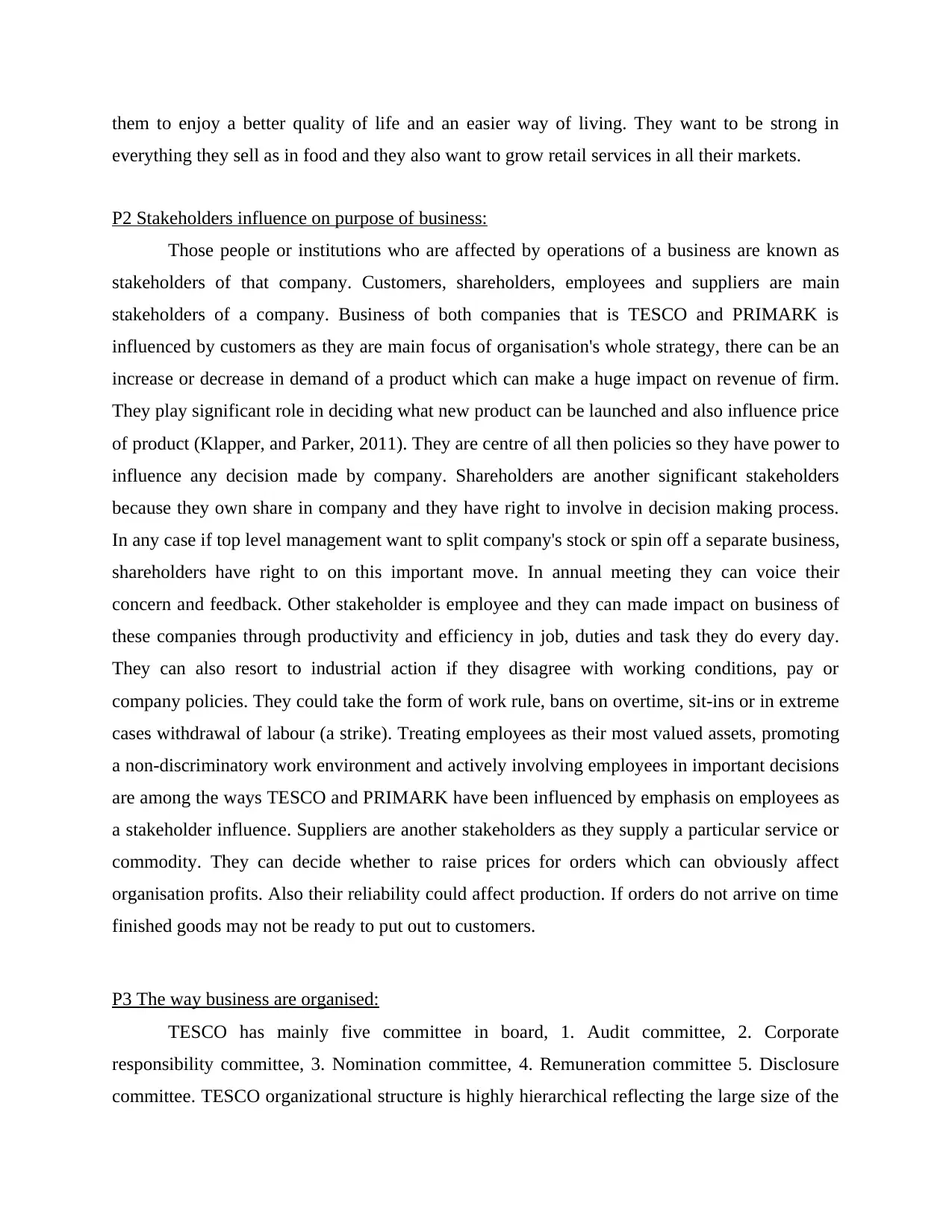
them to enjoy a better quality of life and an easier way of living. They want to be strong in
everything they sell as in food and they also want to grow retail services in all their markets.
P2 Stakeholders influence on purpose of business:
Those people or institutions who are affected by operations of a business are known as
stakeholders of that company. Customers, shareholders, employees and suppliers are main
stakeholders of a company. Business of both companies that is TESCO and PRIMARK is
influenced by customers as they are main focus of organisation's whole strategy, there can be an
increase or decrease in demand of a product which can make a huge impact on revenue of firm.
They play significant role in deciding what new product can be launched and also influence price
of product (Klapper, and Parker, 2011). They are centre of all then policies so they have power to
influence any decision made by company. Shareholders are another significant stakeholders
because they own share in company and they have right to involve in decision making process.
In any case if top level management want to split company's stock or spin off a separate business,
shareholders have right to on this important move. In annual meeting they can voice their
concern and feedback. Other stakeholder is employee and they can made impact on business of
these companies through productivity and efficiency in job, duties and task they do every day.
They can also resort to industrial action if they disagree with working conditions, pay or
company policies. They could take the form of work rule, bans on overtime, sit-ins or in extreme
cases withdrawal of labour (a strike). Treating employees as their most valued assets, promoting
a non-discriminatory work environment and actively involving employees in important decisions
are among the ways TESCO and PRIMARK have been influenced by emphasis on employees as
a stakeholder influence. Suppliers are another stakeholders as they supply a particular service or
commodity. They can decide whether to raise prices for orders which can obviously affect
organisation profits. Also their reliability could affect production. If orders do not arrive on time
finished goods may not be ready to put out to customers.
P3 The way business are organised:
TESCO has mainly five committee in board, 1. Audit committee, 2. Corporate
responsibility committee, 3. Nomination committee, 4. Remuneration committee 5. Disclosure
committee. TESCO organizational structure is highly hierarchical reflecting the large size of the
everything they sell as in food and they also want to grow retail services in all their markets.
P2 Stakeholders influence on purpose of business:
Those people or institutions who are affected by operations of a business are known as
stakeholders of that company. Customers, shareholders, employees and suppliers are main
stakeholders of a company. Business of both companies that is TESCO and PRIMARK is
influenced by customers as they are main focus of organisation's whole strategy, there can be an
increase or decrease in demand of a product which can make a huge impact on revenue of firm.
They play significant role in deciding what new product can be launched and also influence price
of product (Klapper, and Parker, 2011). They are centre of all then policies so they have power to
influence any decision made by company. Shareholders are another significant stakeholders
because they own share in company and they have right to involve in decision making process.
In any case if top level management want to split company's stock or spin off a separate business,
shareholders have right to on this important move. In annual meeting they can voice their
concern and feedback. Other stakeholder is employee and they can made impact on business of
these companies through productivity and efficiency in job, duties and task they do every day.
They can also resort to industrial action if they disagree with working conditions, pay or
company policies. They could take the form of work rule, bans on overtime, sit-ins or in extreme
cases withdrawal of labour (a strike). Treating employees as their most valued assets, promoting
a non-discriminatory work environment and actively involving employees in important decisions
are among the ways TESCO and PRIMARK have been influenced by emphasis on employees as
a stakeholder influence. Suppliers are another stakeholders as they supply a particular service or
commodity. They can decide whether to raise prices for orders which can obviously affect
organisation profits. Also their reliability could affect production. If orders do not arrive on time
finished goods may not be ready to put out to customers.
P3 The way business are organised:
TESCO has mainly five committee in board, 1. Audit committee, 2. Corporate
responsibility committee, 3. Nomination committee, 4. Remuneration committee 5. Disclosure
committee. TESCO organizational structure is highly hierarchical reflecting the large size of the
Secure Best Marks with AI Grader
Need help grading? Try our AI Grader for instant feedback on your assignments.
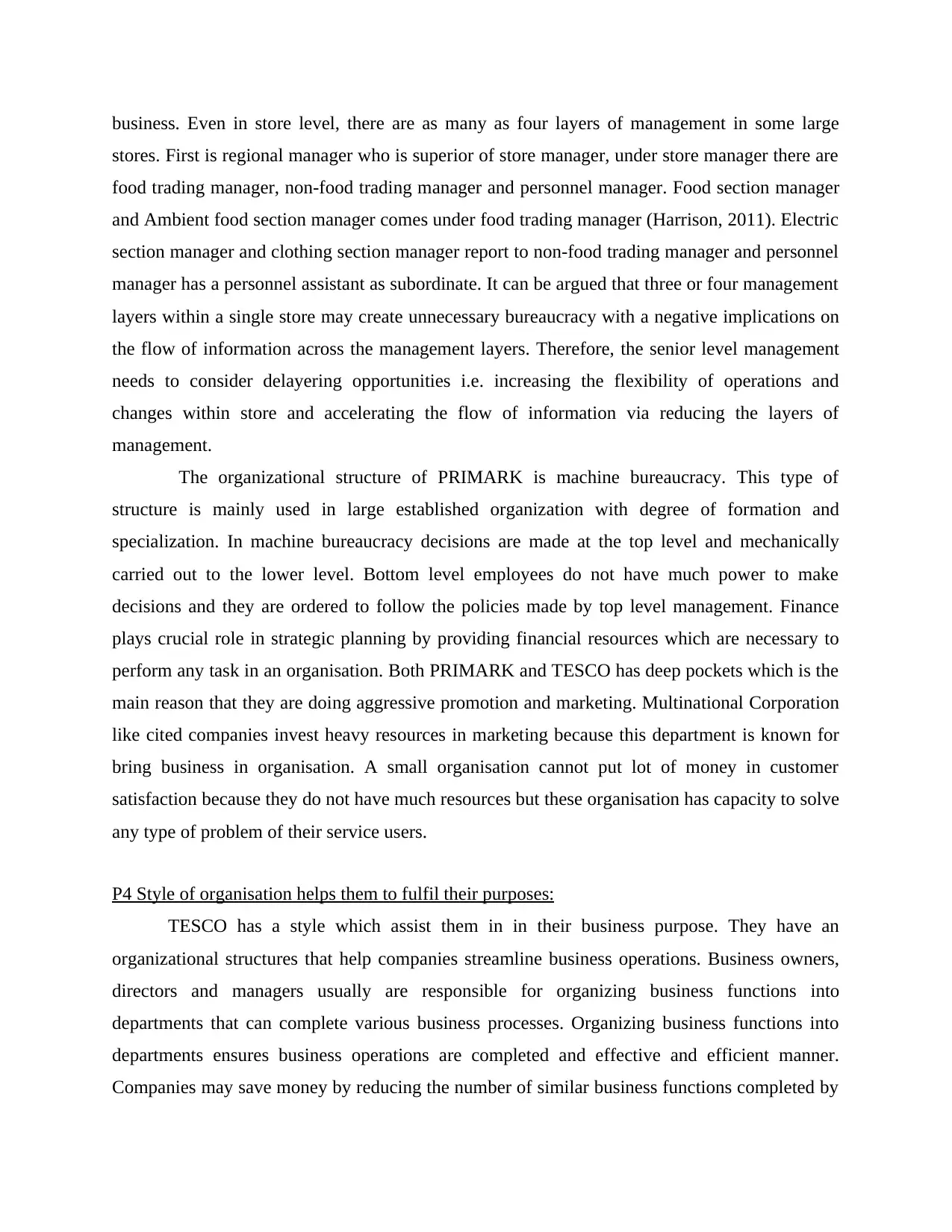
business. Even in store level, there are as many as four layers of management in some large
stores. First is regional manager who is superior of store manager, under store manager there are
food trading manager, non-food trading manager and personnel manager. Food section manager
and Ambient food section manager comes under food trading manager (Harrison, 2011). Electric
section manager and clothing section manager report to non-food trading manager and personnel
manager has a personnel assistant as subordinate. It can be argued that three or four management
layers within a single store may create unnecessary bureaucracy with a negative implications on
the flow of information across the management layers. Therefore, the senior level management
needs to consider delayering opportunities i.e. increasing the flexibility of operations and
changes within store and accelerating the flow of information via reducing the layers of
management.
The organizational structure of PRIMARK is machine bureaucracy. This type of
structure is mainly used in large established organization with degree of formation and
specialization. In machine bureaucracy decisions are made at the top level and mechanically
carried out to the lower level. Bottom level employees do not have much power to make
decisions and they are ordered to follow the policies made by top level management. Finance
plays crucial role in strategic planning by providing financial resources which are necessary to
perform any task in an organisation. Both PRIMARK and TESCO has deep pockets which is the
main reason that they are doing aggressive promotion and marketing. Multinational Corporation
like cited companies invest heavy resources in marketing because this department is known for
bring business in organisation. A small organisation cannot put lot of money in customer
satisfaction because they do not have much resources but these organisation has capacity to solve
any type of problem of their service users.
P4 Style of organisation helps them to fulfil their purposes:
TESCO has a style which assist them in in their business purpose. They have an
organizational structures that help companies streamline business operations. Business owners,
directors and managers usually are responsible for organizing business functions into
departments that can complete various business processes. Organizing business functions into
departments ensures business operations are completed and effective and efficient manner.
Companies may save money by reducing the number of similar business functions completed by
stores. First is regional manager who is superior of store manager, under store manager there are
food trading manager, non-food trading manager and personnel manager. Food section manager
and Ambient food section manager comes under food trading manager (Harrison, 2011). Electric
section manager and clothing section manager report to non-food trading manager and personnel
manager has a personnel assistant as subordinate. It can be argued that three or four management
layers within a single store may create unnecessary bureaucracy with a negative implications on
the flow of information across the management layers. Therefore, the senior level management
needs to consider delayering opportunities i.e. increasing the flexibility of operations and
changes within store and accelerating the flow of information via reducing the layers of
management.
The organizational structure of PRIMARK is machine bureaucracy. This type of
structure is mainly used in large established organization with degree of formation and
specialization. In machine bureaucracy decisions are made at the top level and mechanically
carried out to the lower level. Bottom level employees do not have much power to make
decisions and they are ordered to follow the policies made by top level management. Finance
plays crucial role in strategic planning by providing financial resources which are necessary to
perform any task in an organisation. Both PRIMARK and TESCO has deep pockets which is the
main reason that they are doing aggressive promotion and marketing. Multinational Corporation
like cited companies invest heavy resources in marketing because this department is known for
bring business in organisation. A small organisation cannot put lot of money in customer
satisfaction because they do not have much resources but these organisation has capacity to solve
any type of problem of their service users.
P4 Style of organisation helps them to fulfil their purposes:
TESCO has a style which assist them in in their business purpose. They have an
organizational structures that help companies streamline business operations. Business owners,
directors and managers usually are responsible for organizing business functions into
departments that can complete various business processes. Organizing business functions into
departments ensures business operations are completed and effective and efficient manner.
Companies may save money by reducing the number of similar business functions completed by
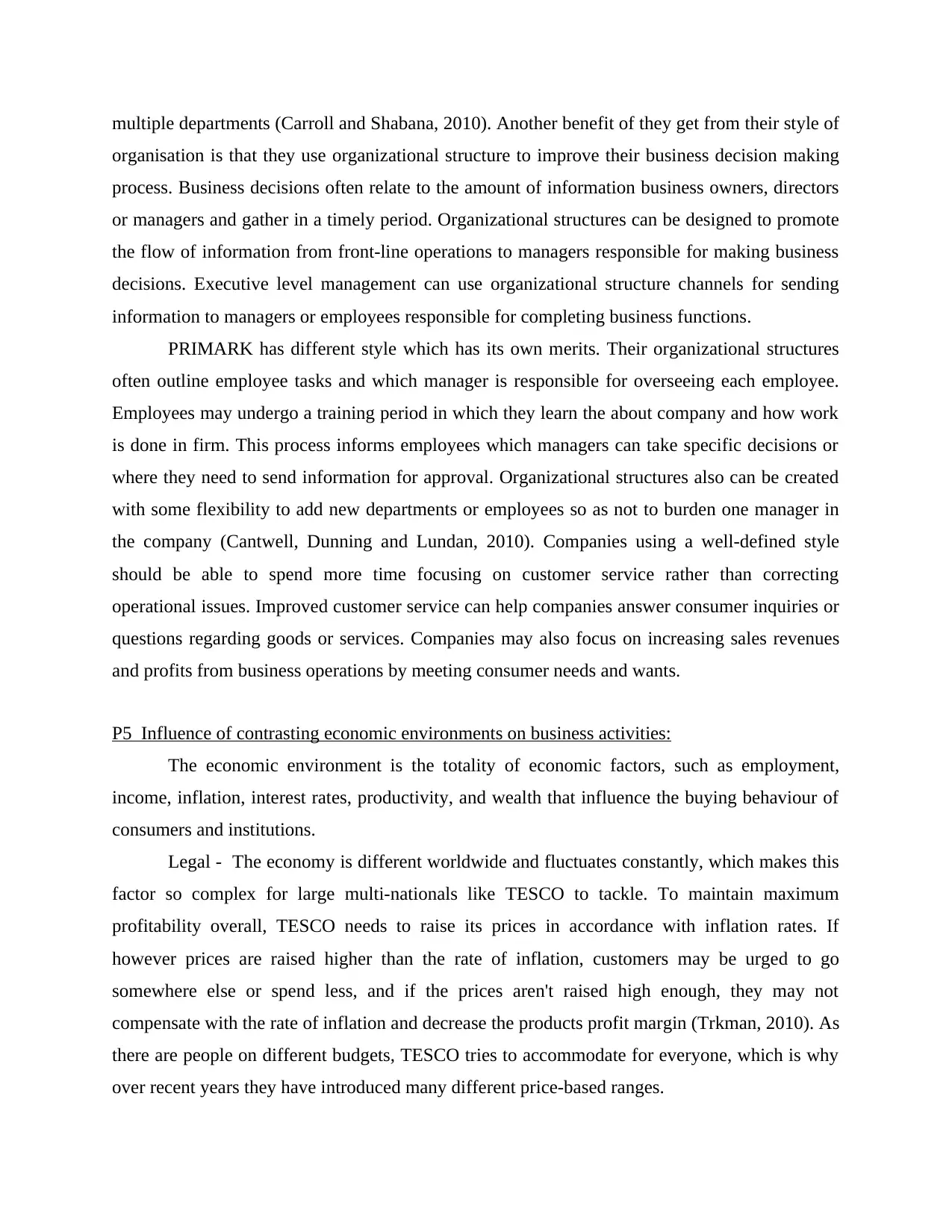
multiple departments (Carroll and Shabana, 2010). Another benefit of they get from their style of
organisation is that they use organizational structure to improve their business decision making
process. Business decisions often relate to the amount of information business owners, directors
or managers and gather in a timely period. Organizational structures can be designed to promote
the flow of information from front-line operations to managers responsible for making business
decisions. Executive level management can use organizational structure channels for sending
information to managers or employees responsible for completing business functions.
PRIMARK has different style which has its own merits. Their organizational structures
often outline employee tasks and which manager is responsible for overseeing each employee.
Employees may undergo a training period in which they learn the about company and how work
is done in firm. This process informs employees which managers can take specific decisions or
where they need to send information for approval. Organizational structures also can be created
with some flexibility to add new departments or employees so as not to burden one manager in
the company (Cantwell, Dunning and Lundan, 2010). Companies using a well-defined style
should be able to spend more time focusing on customer service rather than correcting
operational issues. Improved customer service can help companies answer consumer inquiries or
questions regarding goods or services. Companies may also focus on increasing sales revenues
and profits from business operations by meeting consumer needs and wants.
P5 Influence of contrasting economic environments on business activities:
The economic environment is the totality of economic factors, such as employment,
income, inflation, interest rates, productivity, and wealth that influence the buying behaviour of
consumers and institutions.
Legal - The economy is different worldwide and fluctuates constantly, which makes this
factor so complex for large multi-nationals like TESCO to tackle. To maintain maximum
profitability overall, TESCO needs to raise its prices in accordance with inflation rates. If
however prices are raised higher than the rate of inflation, customers may be urged to go
somewhere else or spend less, and if the prices aren't raised high enough, they may not
compensate with the rate of inflation and decrease the products profit margin (Trkman, 2010). As
there are people on different budgets, TESCO tries to accommodate for everyone, which is why
over recent years they have introduced many different price-based ranges.
organisation is that they use organizational structure to improve their business decision making
process. Business decisions often relate to the amount of information business owners, directors
or managers and gather in a timely period. Organizational structures can be designed to promote
the flow of information from front-line operations to managers responsible for making business
decisions. Executive level management can use organizational structure channels for sending
information to managers or employees responsible for completing business functions.
PRIMARK has different style which has its own merits. Their organizational structures
often outline employee tasks and which manager is responsible for overseeing each employee.
Employees may undergo a training period in which they learn the about company and how work
is done in firm. This process informs employees which managers can take specific decisions or
where they need to send information for approval. Organizational structures also can be created
with some flexibility to add new departments or employees so as not to burden one manager in
the company (Cantwell, Dunning and Lundan, 2010). Companies using a well-defined style
should be able to spend more time focusing on customer service rather than correcting
operational issues. Improved customer service can help companies answer consumer inquiries or
questions regarding goods or services. Companies may also focus on increasing sales revenues
and profits from business operations by meeting consumer needs and wants.
P5 Influence of contrasting economic environments on business activities:
The economic environment is the totality of economic factors, such as employment,
income, inflation, interest rates, productivity, and wealth that influence the buying behaviour of
consumers and institutions.
Legal - The economy is different worldwide and fluctuates constantly, which makes this
factor so complex for large multi-nationals like TESCO to tackle. To maintain maximum
profitability overall, TESCO needs to raise its prices in accordance with inflation rates. If
however prices are raised higher than the rate of inflation, customers may be urged to go
somewhere else or spend less, and if the prices aren't raised high enough, they may not
compensate with the rate of inflation and decrease the products profit margin (Trkman, 2010). As
there are people on different budgets, TESCO tries to accommodate for everyone, which is why
over recent years they have introduced many different price-based ranges.
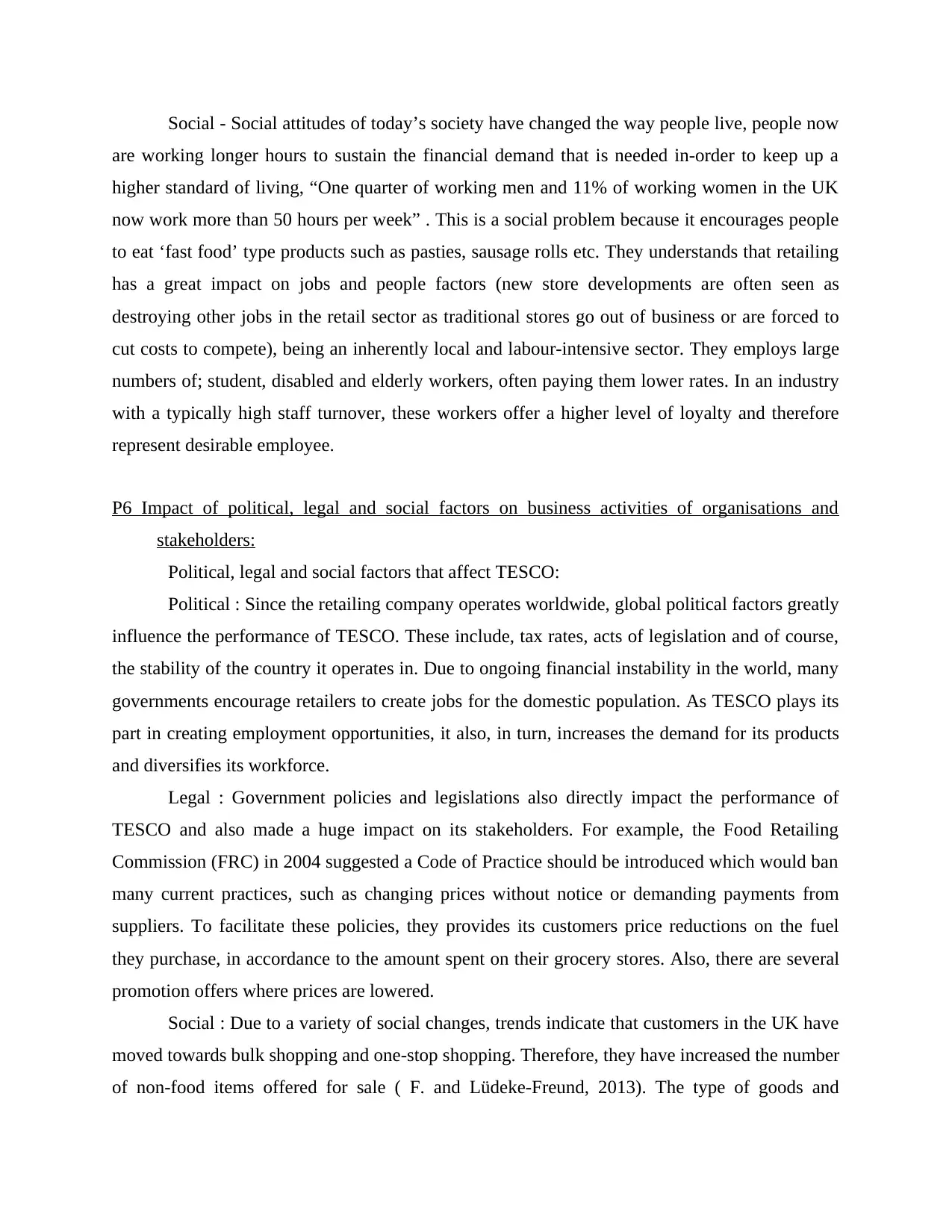
Social - Social attitudes of today’s society have changed the way people live, people now
are working longer hours to sustain the financial demand that is needed in-order to keep up a
higher standard of living, “One quarter of working men and 11% of working women in the UK
now work more than 50 hours per week” . This is a social problem because it encourages people
to eat ‘fast food’ type products such as pasties, sausage rolls etc. They understands that retailing
has a great impact on jobs and people factors (new store developments are often seen as
destroying other jobs in the retail sector as traditional stores go out of business or are forced to
cut costs to compete), being an inherently local and labour-intensive sector. They employs large
numbers of; student, disabled and elderly workers, often paying them lower rates. In an industry
with a typically high staff turnover, these workers offer a higher level of loyalty and therefore
represent desirable employee.
P6 Impact of political, legal and social factors on business activities of organisations and
stakeholders:
Political, legal and social factors that affect TESCO:
Political : Since the retailing company operates worldwide, global political factors greatly
influence the performance of TESCO. These include, tax rates, acts of legislation and of course,
the stability of the country it operates in. Due to ongoing financial instability in the world, many
governments encourage retailers to create jobs for the domestic population. As TESCO plays its
part in creating employment opportunities, it also, in turn, increases the demand for its products
and diversifies its workforce.
Legal : Government policies and legislations also directly impact the performance of
TESCO and also made a huge impact on its stakeholders. For example, the Food Retailing
Commission (FRC) in 2004 suggested a Code of Practice should be introduced which would ban
many current practices, such as changing prices without notice or demanding payments from
suppliers. To facilitate these policies, they provides its customers price reductions on the fuel
they purchase, in accordance to the amount spent on their grocery stores. Also, there are several
promotion offers where prices are lowered.
Social : Due to a variety of social changes, trends indicate that customers in the UK have
moved towards bulk shopping and one-stop shopping. Therefore, they have increased the number
of non-food items offered for sale ( F. and Lüdeke-Freund, 2013). The type of goods and
are working longer hours to sustain the financial demand that is needed in-order to keep up a
higher standard of living, “One quarter of working men and 11% of working women in the UK
now work more than 50 hours per week” . This is a social problem because it encourages people
to eat ‘fast food’ type products such as pasties, sausage rolls etc. They understands that retailing
has a great impact on jobs and people factors (new store developments are often seen as
destroying other jobs in the retail sector as traditional stores go out of business or are forced to
cut costs to compete), being an inherently local and labour-intensive sector. They employs large
numbers of; student, disabled and elderly workers, often paying them lower rates. In an industry
with a typically high staff turnover, these workers offer a higher level of loyalty and therefore
represent desirable employee.
P6 Impact of political, legal and social factors on business activities of organisations and
stakeholders:
Political, legal and social factors that affect TESCO:
Political : Since the retailing company operates worldwide, global political factors greatly
influence the performance of TESCO. These include, tax rates, acts of legislation and of course,
the stability of the country it operates in. Due to ongoing financial instability in the world, many
governments encourage retailers to create jobs for the domestic population. As TESCO plays its
part in creating employment opportunities, it also, in turn, increases the demand for its products
and diversifies its workforce.
Legal : Government policies and legislations also directly impact the performance of
TESCO and also made a huge impact on its stakeholders. For example, the Food Retailing
Commission (FRC) in 2004 suggested a Code of Practice should be introduced which would ban
many current practices, such as changing prices without notice or demanding payments from
suppliers. To facilitate these policies, they provides its customers price reductions on the fuel
they purchase, in accordance to the amount spent on their grocery stores. Also, there are several
promotion offers where prices are lowered.
Social : Due to a variety of social changes, trends indicate that customers in the UK have
moved towards bulk shopping and one-stop shopping. Therefore, they have increased the number
of non-food items offered for sale ( F. and Lüdeke-Freund, 2013). The type of goods and
Paraphrase This Document
Need a fresh take? Get an instant paraphrase of this document with our AI Paraphraser
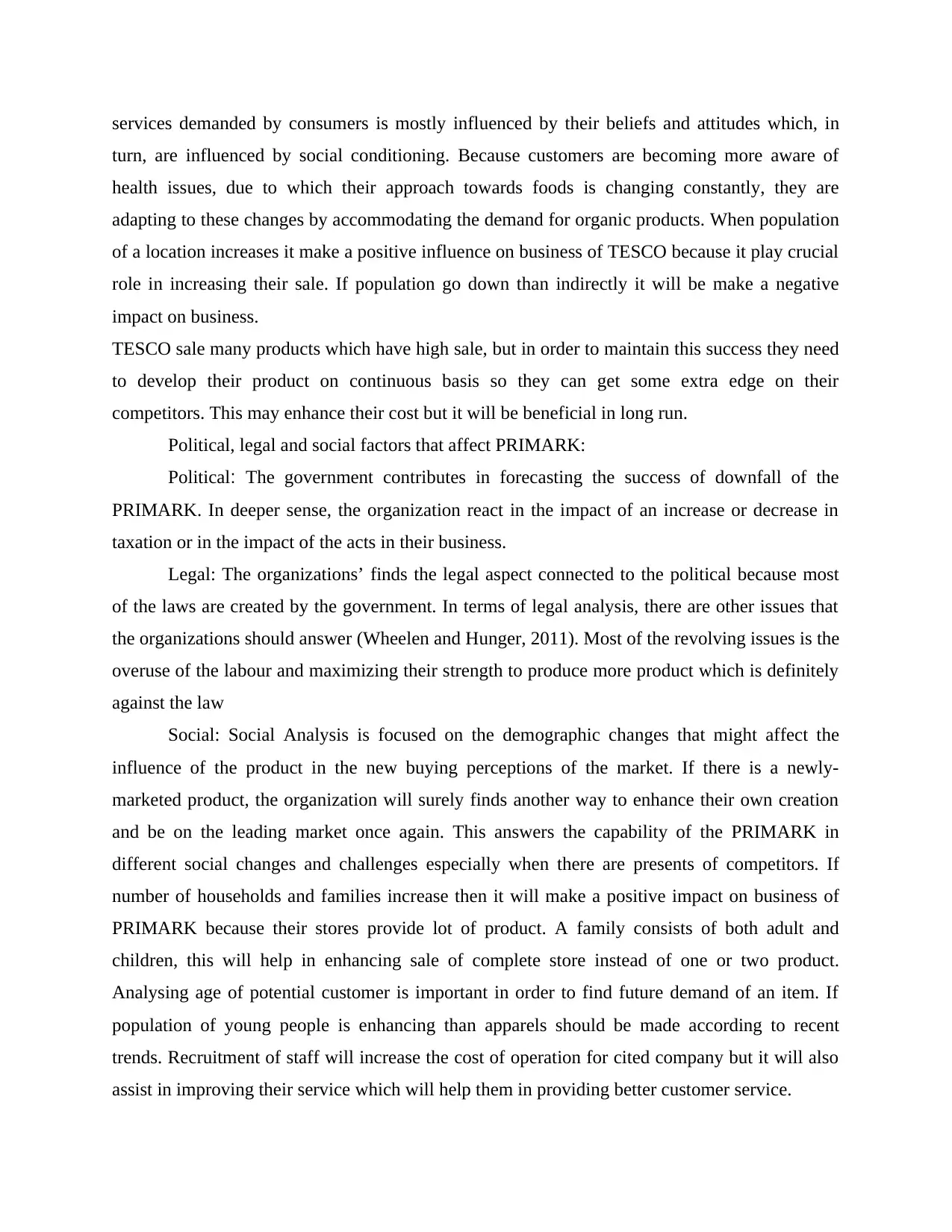
services demanded by consumers is mostly influenced by their beliefs and attitudes which, in
turn, are influenced by social conditioning. Because customers are becoming more aware of
health issues, due to which their approach towards foods is changing constantly, they are
adapting to these changes by accommodating the demand for organic products. When population
of a location increases it make a positive influence on business of TESCO because it play crucial
role in increasing their sale. If population go down than indirectly it will be make a negative
impact on business.
TESCO sale many products which have high sale, but in order to maintain this success they need
to develop their product on continuous basis so they can get some extra edge on their
competitors. This may enhance their cost but it will be beneficial in long run.
Political, legal and social factors that affect PRIMARK:
Political: The government contributes in forecasting the success of downfall of the
PRIMARK. In deeper sense, the organization react in the impact of an increase or decrease in
taxation or in the impact of the acts in their business.
Legal: The organizations’ finds the legal aspect connected to the political because most
of the laws are created by the government. In terms of legal analysis, there are other issues that
the organizations should answer (Wheelen and Hunger, 2011). Most of the revolving issues is the
overuse of the labour and maximizing their strength to produce more product which is definitely
against the law
Social: Social Analysis is focused on the demographic changes that might affect the
influence of the product in the new buying perceptions of the market. If there is a newly-
marketed product, the organization will surely finds another way to enhance their own creation
and be on the leading market once again. This answers the capability of the PRIMARK in
different social changes and challenges especially when there are presents of competitors. If
number of households and families increase then it will make a positive impact on business of
PRIMARK because their stores provide lot of product. A family consists of both adult and
children, this will help in enhancing sale of complete store instead of one or two product.
Analysing age of potential customer is important in order to find future demand of an item. If
population of young people is enhancing than apparels should be made according to recent
trends. Recruitment of staff will increase the cost of operation for cited company but it will also
assist in improving their service which will help them in providing better customer service.
turn, are influenced by social conditioning. Because customers are becoming more aware of
health issues, due to which their approach towards foods is changing constantly, they are
adapting to these changes by accommodating the demand for organic products. When population
of a location increases it make a positive influence on business of TESCO because it play crucial
role in increasing their sale. If population go down than indirectly it will be make a negative
impact on business.
TESCO sale many products which have high sale, but in order to maintain this success they need
to develop their product on continuous basis so they can get some extra edge on their
competitors. This may enhance their cost but it will be beneficial in long run.
Political, legal and social factors that affect PRIMARK:
Political: The government contributes in forecasting the success of downfall of the
PRIMARK. In deeper sense, the organization react in the impact of an increase or decrease in
taxation or in the impact of the acts in their business.
Legal: The organizations’ finds the legal aspect connected to the political because most
of the laws are created by the government. In terms of legal analysis, there are other issues that
the organizations should answer (Wheelen and Hunger, 2011). Most of the revolving issues is the
overuse of the labour and maximizing their strength to produce more product which is definitely
against the law
Social: Social Analysis is focused on the demographic changes that might affect the
influence of the product in the new buying perceptions of the market. If there is a newly-
marketed product, the organization will surely finds another way to enhance their own creation
and be on the leading market once again. This answers the capability of the PRIMARK in
different social changes and challenges especially when there are presents of competitors. If
number of households and families increase then it will make a positive impact on business of
PRIMARK because their stores provide lot of product. A family consists of both adult and
children, this will help in enhancing sale of complete store instead of one or two product.
Analysing age of potential customer is important in order to find future demand of an item. If
population of young people is enhancing than apparels should be made according to recent
trends. Recruitment of staff will increase the cost of operation for cited company but it will also
assist in improving their service which will help them in providing better customer service.
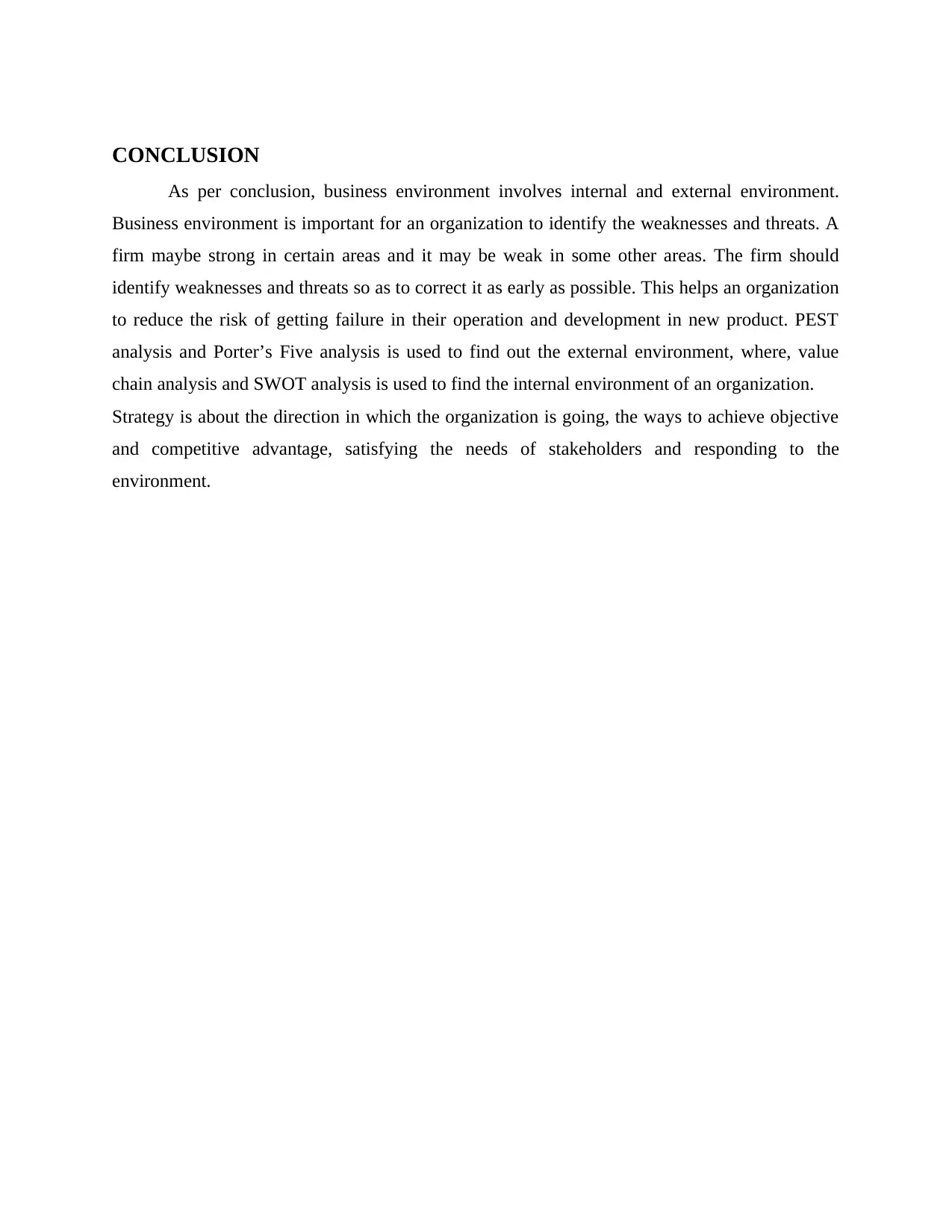
CONCLUSION
As per conclusion, business environment involves internal and external environment.
Business environment is important for an organization to identify the weaknesses and threats. A
firm maybe strong in certain areas and it may be weak in some other areas. The firm should
identify weaknesses and threats so as to correct it as early as possible. This helps an organization
to reduce the risk of getting failure in their operation and development in new product. PEST
analysis and Porter’s Five analysis is used to find out the external environment, where, value
chain analysis and SWOT analysis is used to find the internal environment of an organization.
Strategy is about the direction in which the organization is going, the ways to achieve objective
and competitive advantage, satisfying the needs of stakeholders and responding to the
environment.
As per conclusion, business environment involves internal and external environment.
Business environment is important for an organization to identify the weaknesses and threats. A
firm maybe strong in certain areas and it may be weak in some other areas. The firm should
identify weaknesses and threats so as to correct it as early as possible. This helps an organization
to reduce the risk of getting failure in their operation and development in new product. PEST
analysis and Porter’s Five analysis is used to find out the external environment, where, value
chain analysis and SWOT analysis is used to find the internal environment of an organization.
Strategy is about the direction in which the organization is going, the ways to achieve objective
and competitive advantage, satisfying the needs of stakeholders and responding to the
environment.
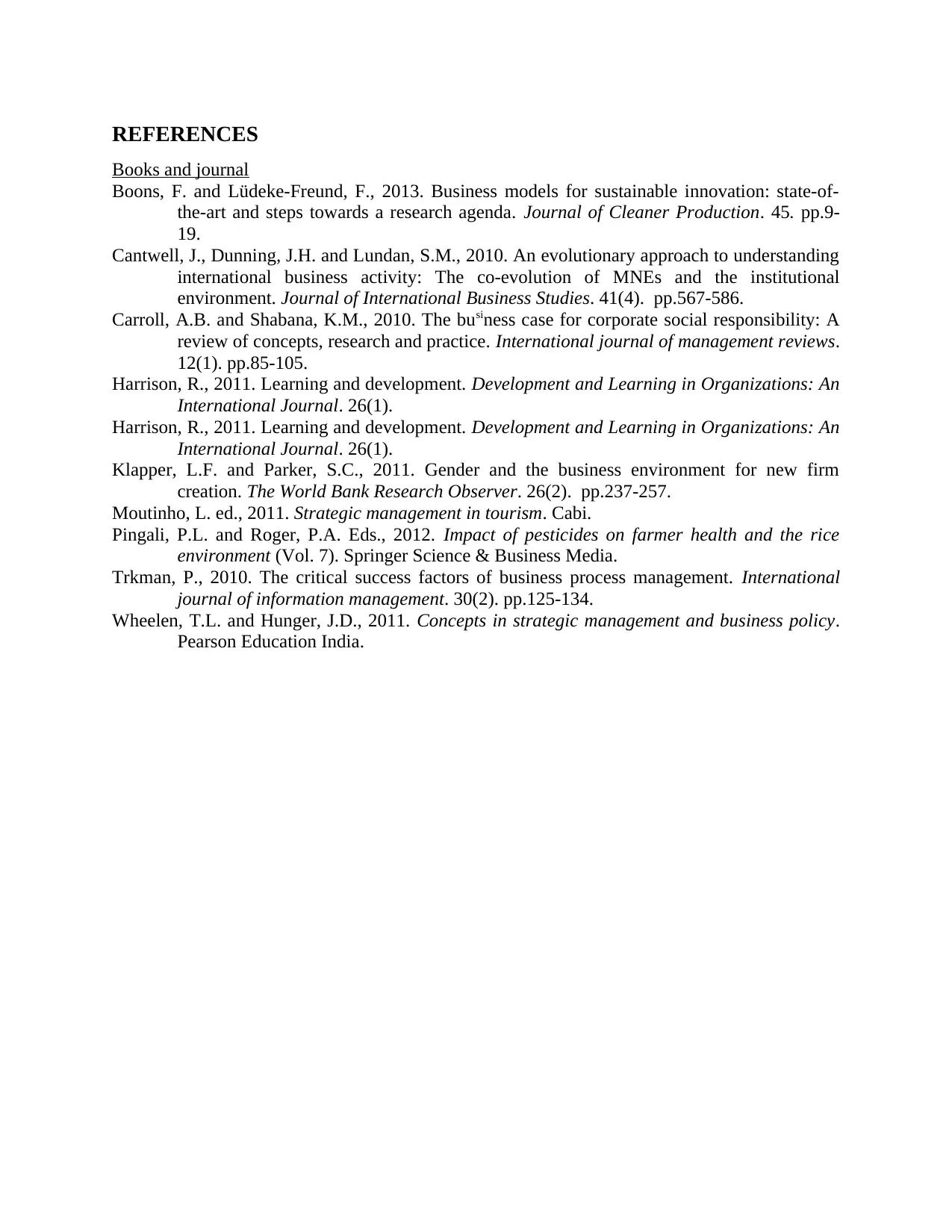
REFERENCES
Books and journal
Boons, F. and Lüdeke-Freund, F., 2013. Business models for sustainable innovation: state-of-
the-art and steps towards a research agenda. Journal of Cleaner Production. 45. pp.9-
19.
Cantwell, J., Dunning, J.H. and Lundan, S.M., 2010. An evolutionary approach to understanding
international business activity: The co-evolution of MNEs and the institutional
environment. Journal of International Business Studies. 41(4). pp.567-586.
Carroll, A.B. and Shabana, K.M., 2010. The business case for corporate social responsibility: A
review of concepts, research and practice. International journal of management reviews.
12(1). pp.85-105.
Harrison, R., 2011. Learning and development. Development and Learning in Organizations: An
International Journal. 26(1).
Harrison, R., 2011. Learning and development. Development and Learning in Organizations: An
International Journal. 26(1).
Klapper, L.F. and Parker, S.C., 2011. Gender and the business environment for new firm
creation. The World Bank Research Observer. 26(2). pp.237-257.
Moutinho, L. ed., 2011. Strategic management in tourism. Cabi.
Pingali, P.L. and Roger, P.A. Eds., 2012. Impact of pesticides on farmer health and the rice
environment (Vol. 7). Springer Science & Business Media.
Trkman, P., 2010. The critical success factors of business process management. International
journal of information management. 30(2). pp.125-134.
Wheelen, T.L. and Hunger, J.D., 2011. Concepts in strategic management and business policy.
Pearson Education India.
Books and journal
Boons, F. and Lüdeke-Freund, F., 2013. Business models for sustainable innovation: state-of-
the-art and steps towards a research agenda. Journal of Cleaner Production. 45. pp.9-
19.
Cantwell, J., Dunning, J.H. and Lundan, S.M., 2010. An evolutionary approach to understanding
international business activity: The co-evolution of MNEs and the institutional
environment. Journal of International Business Studies. 41(4). pp.567-586.
Carroll, A.B. and Shabana, K.M., 2010. The business case for corporate social responsibility: A
review of concepts, research and practice. International journal of management reviews.
12(1). pp.85-105.
Harrison, R., 2011. Learning and development. Development and Learning in Organizations: An
International Journal. 26(1).
Harrison, R., 2011. Learning and development. Development and Learning in Organizations: An
International Journal. 26(1).
Klapper, L.F. and Parker, S.C., 2011. Gender and the business environment for new firm
creation. The World Bank Research Observer. 26(2). pp.237-257.
Moutinho, L. ed., 2011. Strategic management in tourism. Cabi.
Pingali, P.L. and Roger, P.A. Eds., 2012. Impact of pesticides on farmer health and the rice
environment (Vol. 7). Springer Science & Business Media.
Trkman, P., 2010. The critical success factors of business process management. International
journal of information management. 30(2). pp.125-134.
Wheelen, T.L. and Hunger, J.D., 2011. Concepts in strategic management and business policy.
Pearson Education India.
Secure Best Marks with AI Grader
Need help grading? Try our AI Grader for instant feedback on your assignments.
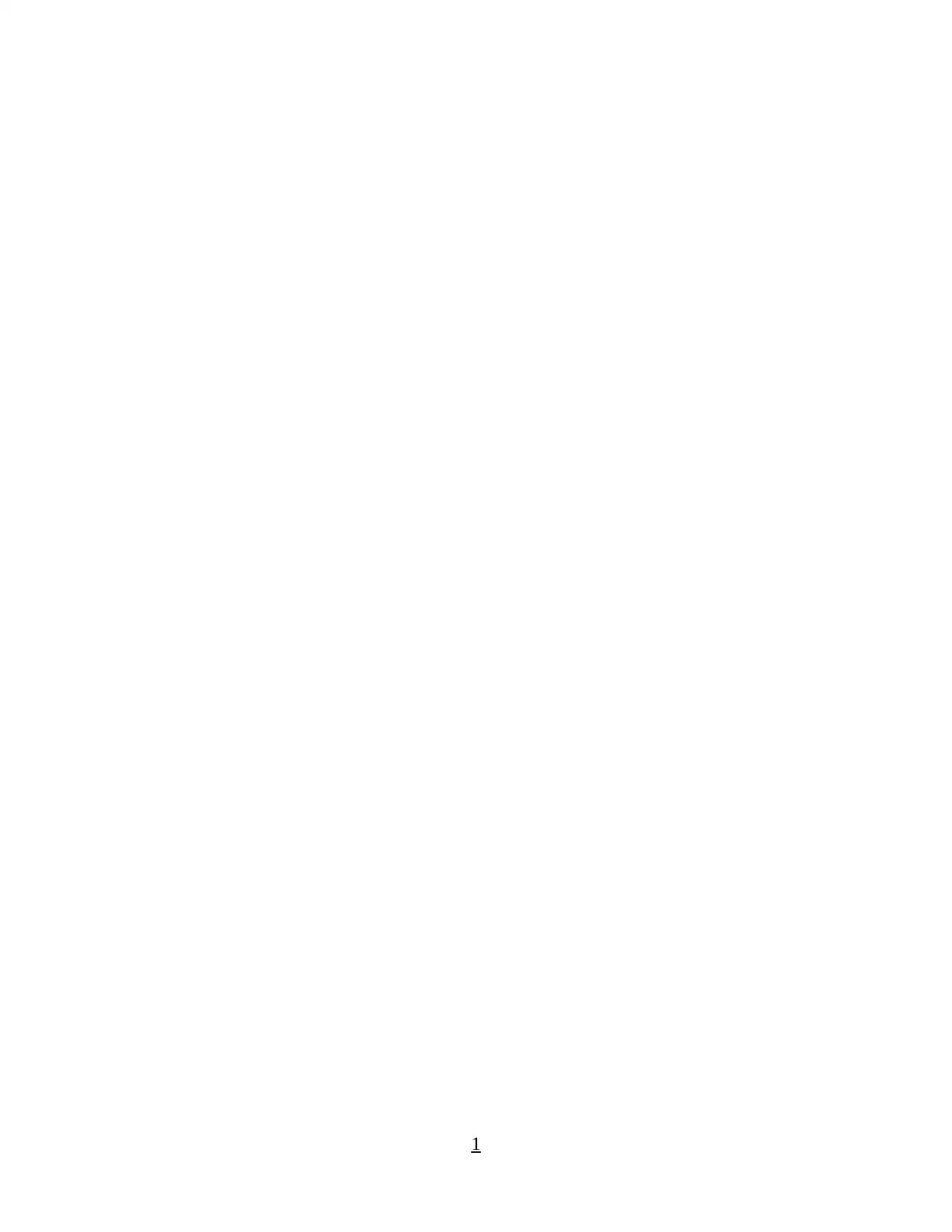
1
1 out of 11
Related Documents
Your All-in-One AI-Powered Toolkit for Academic Success.
+13062052269
info@desklib.com
Available 24*7 on WhatsApp / Email
![[object Object]](/_next/static/media/star-bottom.7253800d.svg)
Unlock your academic potential
© 2024 | Zucol Services PVT LTD | All rights reserved.




